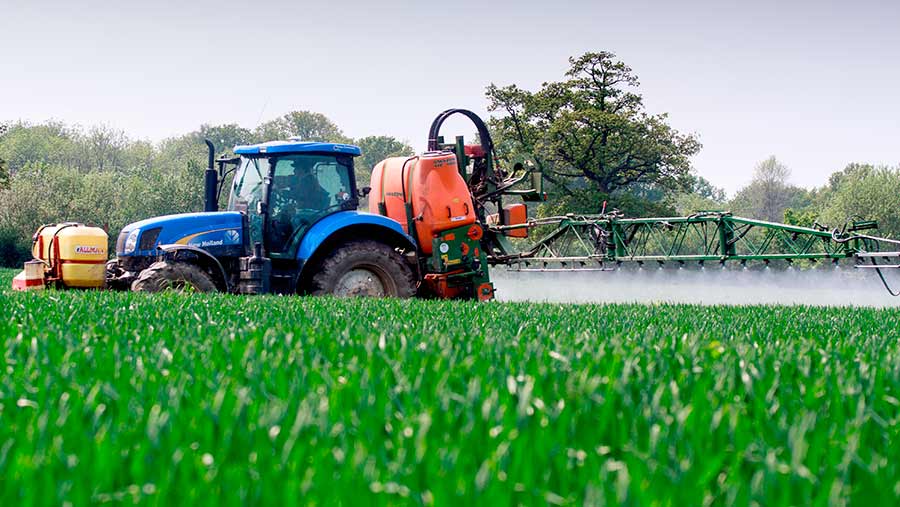Crop Watch: Bolting beans and drought stress
 © Malcolm Case-Green
© Malcolm Case-Green The large swings in temperature and rainfall in recent weeks are taking their toll.
With memories of flooded fields still fresh in the mind, some crops are now showing signs of drought stress, partly due to their underdeveloped root systems.
The extremes in temperature have even led to crops bolting, with reports of spring beans flowering while only 4in tall.
See also: Crop Watch: Spray now to tackle septoria burden
Oilseed rape crops in the North, as well as winter barleys are struggling. The one glimmer of hope is spring barley, and growers are being advised to think of growth regulation to help stimulate rooting and tillering.

Kevin Knight
South: Kevin Knight
Zantra (Kent)
There has been a lot of weather fluctuations this May. Temperatures from high 20s down to frosts, 3in of rain in a 24-hour period with another 1in a couple of days later.
Now spring-drilled crops could do with a drop, but are enjoying some warmth after a week of cold, harsh northerlies.
Fluctuations between these extremes have made some crops bolt and others sit still. With spring beans it’s both – bolting to flowering while sitting at 4in tall (not helping them grow away from weevil pressure).
See also: Why growing triticale can help you earn more
Winter cereals look green, superficially clean and generally rather pleasing. They usually do in late May.
Where crops went in well and a reasonable programme was applied (despite the challenges), it is still easy to find septoria on leaf 4, and higher up where compromises or delays went further than they should have.
Stressed crops are showing increases in mildew activity, particularly on sandy areas where drought kicks in earlier.
Yellow rust has been kept in check thus far, but stripes on the odd leaf of Skyfall and Zulu influenced the T2s going on late/second wheats this week. Mine consisted of SDHI (Solatenol) plus a good dose of an azole, some chlorothalonil and a mildewicide.
With heavy rain washing nutrients away, I’m adding a broad-spectrum foliar feed where needed on current and subsequent passes through the crop.
Spring crops
Spring cereals are moving apace now, and close attention to early plant growth regulator and fungicide timing will be necessary.
With spring barley, front load your fungicide spend – get the big guns out early (SDHI + prothioconazole) to keep a clean crop, then you can apply a more economical top-up the second time around.
The warm weather has brought a few bruchid beetles out. It is too early to have much of an effect, as most winter beans are just developing pods on the bottom trusses. However, beware if you are chasing that attractive human consumption premium.
Potato planting is just finished, late, but generally went in well. We have had confirmed cases of blight in dumps in Kent over recent weeks and have hit Hutton periods this week, so where there is a potato canopy, it’s being treated.
Fluazinam isn’t having the desired effect on the EU37 strain, so my programmes will involve mancozeb and cymoxanil until the canopy gets moving rapidly. At that point we’ll use more mobile actives such as propamocarb.

Marcus Mann
East: Marcus Mann
Frontier (Essex)
As the season begins to catch up, the flag leaf has emerged in winter wheat and T2s are under way. The wet weather in March and April has meant there is active Septoria tritici in many crops, with leaves 4 and 5 in susceptible varieties expressing significant visible symptoms.
With the importance of keeping the flag leaf clean, T2 sprays are being based on robust rates of SDHI and azole along with a multisite to prevent any resistance developing.
Yellow rust is also present within the more-susceptible varieties. The addition of a strobilurin will help add additional protection against rust as well as helping to retain green leaf.
Magnesium is the most important nutrient to apply with the T2, as the crops are beginning the period of maximum growth and biomass production. This will also enhance specific weight and protein levels in the grain for all quality wheat crops.
Rapid growth
Spring cereals are racing through their growth stages and reaching their T1 timing. While plant growth regulators are not routine on spring barley, more is now being grown on heavier, more fertile soils for blackgrass control.
With the late drilling, shorter growing period and increased seed-bed nitrogen, this could result in poor rooting leading to poor tiller formation and retention. So manipulating the main apical dominance as well as stem strengthening should be considered, even if not applying a T1 fungicide on the less-disease-susceptible varieties.
Aphid numbers are currently low. However, AHDB/Rothamsted monitoring reports indicate the three main cereal aphids have been found in suction traps. Crops should be considered at risk of barley yellow dwarf virus until growth stage 31.
Black bean aphid has just begun to become active within pulse crops, so monitor as temperatures increase.

Giles Simpson
West: Giles Simpson
Pearce Seeds (Somerset)
What a difference a few weeks make. Crops that were drowning six weeks ago are now looking for a drink. I never thought I would say that. The recent dry spell we all wished for is now stressing crops that have poor root structure following the winter’s wet weather.
The early-season wet conditions meant most of the crops received their fertiliser late. The winter barleys are now really showing this and are generally thin. I don’t hold out much hope of them yielding well, although they are relatively free from disease.
The winter wheats are all over the place in growth stage. Many are now at T2, but I have some backward crops that are still only growth stage 33. This has made for a very taxing season so far.
There is plenty of septoria around and noticeably more where the T0 was omitted or T1 was late due to ground conditions. Siskin looks to be the best at the moment. Of all the late-drilled wheat, Anapolis looks as though it has survived the best and held on to tillers.
Spring barley
The spring crops have emerged very quickly and evenly. The spring barleys have received manganese and growth regulator. Very few weeds have emerged, so these will be dealt with when the fungicide goes on.
Most of the maize is now drilled and is emerging well. Some seed-beds were drying out very quickly and, hopefully, seed has been drilled into moisture. Some pre-emergence sprays have been put on, but in the past week there has been much debate about whether it’s worth doing. Who knows what the next few weeks will bring?
I decided to go with just pendimethalin rather than a more expensive option just in case it stays dry. Some seed rates were lowered to allow for the fact that most maize was being drilled about a fortnight later than normal.

Patrick Stephenson
North: Patrick Stephenson
AICC (Yorkshire)
No two seasons are the same, and this one is certainly different, with huge swings in temperatures – often more than 20C movements in 24 hours. Crops have changed beyond all recognition and although much is aesthetic, it has made crop walking more rewarding.
Oilseed rape crops are a real mix. Some are flowering, some have finished, and some just started. None has really flushed that eye-watering bright yellow. It has been a real task to judge sclerotinia spray timings and even decide if the crop is going to flower.
I will be glad to shut the gate on OSR this year, as everything seems to have conspired to make the crop struggle and I fear the yield outlook is not good.
Similarly, winter barley on heavy land is a sorry sight, and any thoughts of copious straw yields to replenish stocks can be dismissed. Light land crops are more hopeful and all have now received their final fungicide, with chlorothalonil included to combat ramularia.
Spring barley is far more hopeful and despite the late drilling, emergence has been fast. Crops are now receiving herbicides and, depending on plant stand, some are receiving growth regulator to encourage tillering.
Although these crops will be very dependent on the weather, particularly rainfall, over the coming months, they have certainly started well.
Winter wheat crops have at long last picked up and are a rich, dark green, feeding off the reservoir of applied nitrogen. Unfortunately, many are best viewed at 55mph from the road.
Heavy land woes
Once again the heavy land is, in general, not a pretty sight and there certainly is no requirement for further growth regulation. Despite all the early spring rain, septoria is contained in the lower canopy.
Yellow rust is bubbling away and despite many varieties having theoretical good resistance, the rapid changes in strains means no variety can guaranteed resistance.
The recent rapid crop growth, with a new leaf appearing every week, means spray intervals will be short, with some crops receiving three fungicides in the space of six weeks.
At this point, I part company with many of my more learned colleagues, as with such tight spray timings I have no appetite for high SDHI rates and have moved to “appropriate” doses.
Winter beans are now flowering and will be due a chocolate spot spray very soon. Spring beans have emerged well on the whole and weed control is good, with the usual rape volunteers surviving.
These volunteers always cause a headache, with much debate about Basagran (bentazone) and its use. If there is a more frustrating herbicide than Basagran I have yet to meet it. Performance can range from good to “are you sure you put the chemical in?”

